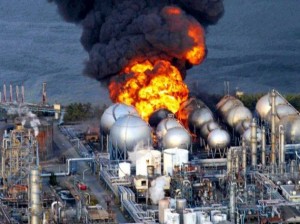Back in the 1960’s Nuclear Power was pitched as “Too Cheap to Meter.” Today the state of the art can be summarized in 15 words:
Chernobyl, Fukushima, San Onofre, Fort Calhoun, Indian Point, Radioactive Waste, Evacuation Plans and Emergency Response.
Chernobyl, Ukraine & Fukushima, Japan
Four Melt-Downs in the 54 years between 1957, when the Price Anderson Act created the industry and 2011; one every 13.5 years. Four melt-downs in 54 years in 200 or so reactors is a failure rate of 2% in 54 years not counting the partial melt-down at Three Mile Island. But considering the catastrophic nature of a melt-down … one melt-down every 13.5 years is one too many. With Nuclear an accident anywhere is an accident everywhere.
San Onofre, California
Decommissioned due to failure. Litigation: Pending. Damages estimated to $2 billion (for a 2 Gigawatt complex). Defense claims liability limited to $157 Million. Good to be a stockholder, not a stakeholder. Or bad to be either. LA Times: Edison starts legal fight with maker of faulty San Onofre generators, here.
Fort Calhoun, Nebraska
Closed for routing refueling in April, 2011. Still closed – 2 years 4 months later and indefinitely due to flooding of the Missouri River. Popular Logistics coverage, here.
Indian Point, New York
A chemist was fired after it was revealed that he falsified documents in an NRC filing. The documents relate to oil quality in emergency generators. Entergy, Corp. reassures the public that there was no danger to the public for this plant 35 miles north of Times Square. The questions I have, however, are:
Entergy seems to have admitted to falsifying documents relating to diesel fuel in backup generators. Did this happen in a vacuum? If not then, what other kinds of falsified documents were filed with the NRC? And was it limited to Indian Point or does it extend to other plants owned by Entergy? And is it limited to Entergy or does it extend to other plants in teh US and worldwide?
Given what we know about nuclear operations at Tepco in Japan and at Areva in France, this is a world wide problem.
According to PR Newswire, here, and Mid-Hudson News, Former Indian Point supervisor arrested on federal charges.
The former chemistry manager at the Indian Point nuclear power plant was arrested on Tuesday and charged with falsifying records to conceal a violation of Nuclear Regulatory Commission requirements of the facility.
Daniel Wilson, 57, of Walden, was responsible for making sure particulate matter in the diesel fuel used to power emergency generators at the facility did not exceed a set limit. In 2011, tests of the diesel fuel showed the particulate matter exceeded the NRC limit.
In February 2012, Wilson concealed facts from his employer and the NRC by fabricating test data for non-existent resamples of the diesel fuel, falsely showing that the resamples of diesel fuel tested below the applicable NRC limit. Investigation revealed that no such samples were taken and the purported test data were fabrications.
Later in February, Wilson responded to questioning from other employees at Indian Point in advance of an inspection by the NRC and wrote a report in which he gave a false explanation for the lack of supporting documentation for his fabricated tests.
Radioactive Wastes, Evacuation Plans and Emergency Response
We need to manage various kinds of wastes, including “spent fuel,” which is radioactive, clothing worn by plant operators, which may be radioactive, and the plants themselves after decommissioning. However, we do not have a long term plan for secure and reliable management of radioactive wastes.
We also don’t have credible evacuation or emergency response plans in the event of disaster at nuclear power plants.
The Future
Back in the 1970’s Amory Lovins, now with the Rocky Mountain Institute, RMI, said, “The least expensive unit of energy is the one you don’t have to buy. ” This, he termed, the “Nega-Watt.” The next least expensive is the one that does not consume fuel an does not create wastes, the “Nega-Fuel-Watt. ”
New Nuclear is estimated at $10 Billion per gigawatt. New Solar is now estimated at $4.0 Billion per gigawatt. New Wind power $2.5 Billion to $3 Billion per gigawatt, depending on location.
We MUST, with all deliberate speed, move from an unsustainable energy paradigm built around fuel and waste to a sustainable paradigm built around the efficient use of solar, wind, geothermal, marine current and sustainable biofuels.
–
A candidate for General Assembly (Site / Join / Contribute) to represent NJ Legislative District 12, which stretches from Matawan to to New Hanover and includes Old Bridge, Manalapan, Englishtown, Roosevelt, Millstone, Jackson, and various other towns (click here), and an analyst with Popular Logistics, Lawrence J. Furman holds a Bachelor’s in Biology, and an MBA in “Managing for Sustainability” from Marlboro College, Vermont. He also has experience in information technology. He can be reached at ‘Larry” at Furman For New Jersey. com.
